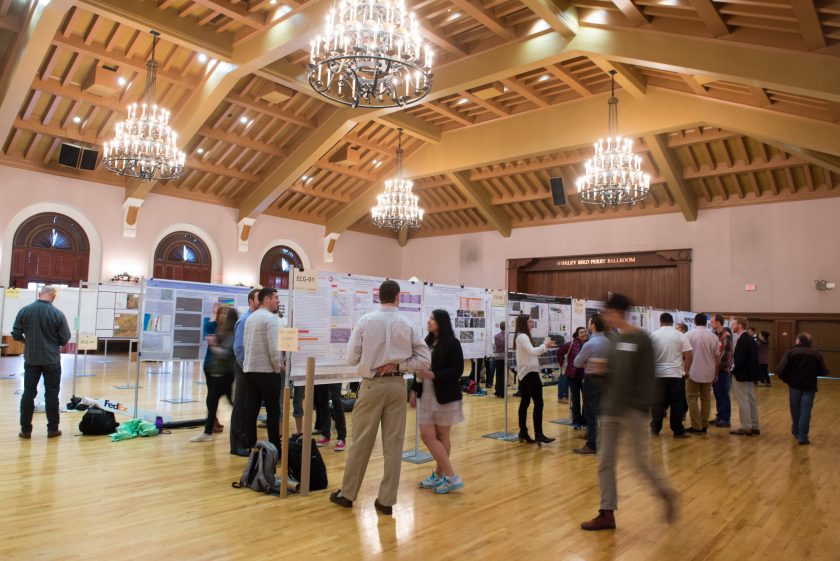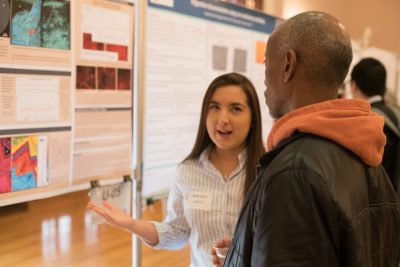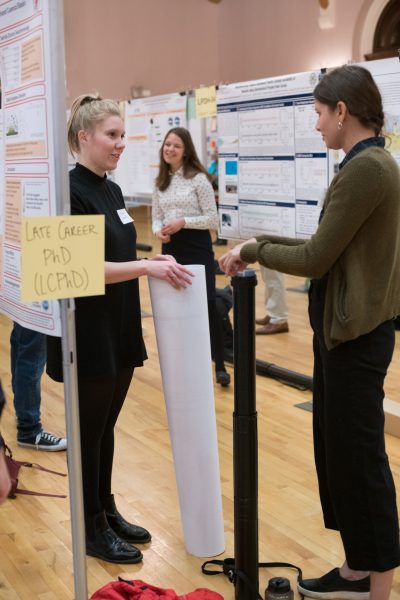Student Science on Display
February 3, 2018

You wouldn’t know it by listening to Raeann Garcia adeptly explain her research on the Lower Ordovician Knox Group, but the undergraduate was feeling a little tense at the Seventh Annual Jackson School Student Research Symposium.
“It’s nerve wracking,” Garcia admitted of her first experience presenting research at a poster session. “But it’s nice that it is here at the Jackson School. I know a lot of the people coming up to me, so I’m more comfortable explaining my work.”

project to Jackson School Director of Outreach
and Diversity Samuel Moore.
That’s one of the chief goals of the student-run event — giving Jackson School students a forum to hone their presentation skills. But the research symposium goes well beyond this objective. Sponsored by ConocoPhillips, the symposium, which occurred on Feb. 3, 2018, offers students a chance to see what their peers throughout the school are working on, as well as the opportunity to meet alumni, faculty and industry representatives who are acting as judges or simply attending the event.
Toti Larson, a research associate at the Jackson School’s Bureau of Economic Geology, has judged the last four symposiums. The event offers him a chance to see the mix of science being conducted around the school, an opportunity that can lead to research collaborations. He also appreciates the learning experience the symposium offers students, particularly the opportunity to discuss their work with people outside of their specialty. This ability is a particularly important and sometimes overlooked career skill. The trick, Larson said, is to step out of your specific research bubble and practice quickly explaining the big picture of your research.
“As a scientist, you spend your time in the weeds. You’re worried about your equations, and you’re worried about some nuance that you know really matters, but you might be one of only a handful of people that know it matters,” he said. “When you go and present your work, it’s really easy to hone in on your comfort zone with these nuanced things and not explain how it fits into the big picture.”

Christensen. Ph.D. student Allison Lawman is in the background.
This year’s event had 110 submissions in four categories: undergraduate, early career graduate, late career master’s, and late career Ph.D.
Several of the students were using the symposium to help prepare for the Lunar and Planetary Science Conference being held in Houston the following month. They included Brandon Tober, an early career graduate student who is studying radar reflectivity analysis of halo-shaped boulder formations on Mars that are thought to be formed by ancient meteor impacts.
“The theory is that there had to be some sort of ice-rich solid mantle and that the impact had to go through that to excavate the boulders and keep their form,” he said.
Late career Ph.D. student Ben Cardenas was presenting research at the symposium that he also plans on presenting at the Lunar and Planetary Science Conference — although in a different form. At the Jackson School Symposium, he was presenting on how ancient dune fields in Arizona developed and how their deposits are affected by ancient environmental conditions. At the Lunar and Planetary Science Conference, he would be presenting a project that used the Arizona work as an analogue for similar formations on Mars.
By this point in his career, Cardenas is well-practiced at poster sessions, but he said he loves the opportunity see what his friends are working on, as well as the undergrads he helps lead in summer field camps.
“This is something UT does particularly well, integrating undergrads into research,” Cardenas said. “It’s good for everyone. It gives undergrads a chance to see what grad school or their careers might be like, communicating their work professionally. It gives grad students a chance to mentor undergrads. It’s one of the best things the Jackson School does.”
Symposium winners
UNDERGRADUATE
- 1st Place: Sebastian Muñoz, Heat Transport in the Streambed of a Large Regulated River
- 2nd Place: Elizabeth Davis, Pyroclastic Flows from Mount St. Helens: The Effects of Topography on Flow Behavior and Deposition on the Leeward Slope
- Honorable Mention: Jordan Oefinger, Evidence of Possible Ocean Acidification at the Paleocene-Early Eocene Boundary Recorded in the Adriatic Carbonate Platform
EARLY CAREER GRADUATE STUDENT
- 1st Place: Brandon Shuck, Constraints on Mantle Dynamics During Jurassic Rifting in the ENAM Area From Seismic and Petrological Modeling of the Oldest Oceanic Crust
- 2nd Place: Carolyn Tewksbury-Christle, Rheological Properties and Heterogeneities Along the Down-Dip Extent of a Subduction Megathrust: Insights From the Condrey Mountain Schist, Northern California
- Honorable Mention: Kelly Olsen, Development of a Shallow Decollement Along the South-Central Chile Margin From 2D Seismic Reflection Data
LATE CAREER MASTERS
- 1st Place: Evelin Gutiérrez, Provenance and Geochronological Insights Into Late Cretaceous-Paleogene Foreland Basin Development in the Subandean Zone and Oriente Basin of Ecuador
- 2nd Place: Sean Bader, Missing Well Log Data Interpolation and Semiautomatic Seismic Well Ties Using Data Matching Techniques
- Honorable Mention: Scott Eckley, 3D Textural and Geochemical Analyses on Carbonado Diamond: Insights from Pores and the Minerals Within Them
LATE CAREER PH.D.
- 1st Place: Alissa Kotowski, Length Scales and Types of Heterogeneities Along the Deep Subduction Interface: Insights From an Exhumed Subduction Complex on Syros Island, Greece
- 2nd Place: Sarah George, Testing Models of Orogenic Development in Ecuador: Multi-proxy Provenance Analysis of the Hinterland Cuenca Basin
- Honorable Mention: Rachel Bernard, Plagioclase-dominated Seismic Anisotropy in the Eastern Mojave Lower Crust
BEST REPRESENTED RESEARCH GROUP
- 1st Place: Whitney Behr
- 2nd Place: Brian Horton
